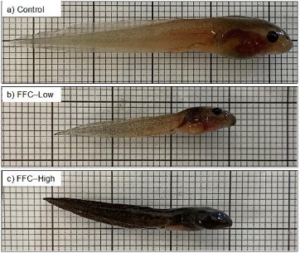A new Griffith study has found that bushfire fighting chemicals commonly marketed as environmentally friendly can severely affect frog development.
Published inAquatic Toxicology, the study assessed two chemicals, Phos-Chek LC95W and BlazeTamer380, used globally as alternatives for firefighting foams containing per- and poly-fluoroalkyl substances (PFASs), the latter of which has a history of detrimental environmental effects, impacting wildlife decades after their use.

“While many current firefighting chemicals are an improvement on past formulations containing PFASs, there has been very little testing done, so we don’t have a good understanding of their ecological impacts, especially on sensitive frog species,” said ecotoxicologist and senior authorDr Chantal Lanctôtfrom theAustralian Rivers Institute’sToxicology Research Group (ARITOX) andFrog Research Team.
“This study shows that run-off or accidental application of these chemicals into small waterways can have significant implications for the growth of frogs, impairing the development of striped marsh frog (Limnodynastes peronii) tadpoles and even leading to death.”
“With global wildfire events becoming more frequent and severe due to the warmer and drier conditions, there is an increasing demand for aggressive and effective bushfire management techniques, using firefighting chemicals, to suppress and stop the fires spreading.”
The recent unprecedented Australian ‘Black Summer’ bushfires saw major world heritage sites burnt and firefighting chemicals applied to otherwise pristine environments that are habitats and breeding sites for many frog species.
With many Australian frog populations experiencing declines and little known about how firefighting chemicals impact at-risk species, this research evaluates the risks of these chemicals to protect key biodiversity assets during fire suppression and management activities.

“The landscape-scale application of firefighting chemicals could have important ramifications for sensitive frog species, especially those already threatened by chytridiomycosis, the deadly disease impacting frog populations globally”, said co-author and wildlife disease expertDr Laura Groganfrom the GriffithCentre for Planetary Health and Food Security.
Therefore, understanding these products’ potential direct and indirect ecological impacts is critical for protecting sensitive and developing frog species, particularly the chemicals’ long-term and sub-lethal effects.
The group noted that over 16 days, both the firefighting chemicals formulations tested affected the growth and development of frogs, with the Phos-Chek formulation causing the death of all but 8% of animals at upper concentrations (1 g/L).
“Delayed growth and development can be a real problem for frogs leading to competitive disadvantages. It reduces breeding success and increases an animal’s susceptibility to predation,” – co-author and threatened species management and conservation expert, Dr Clare Morrison from the Centre for Planetary Health and Food Security.
The authors stress that understanding the ecological risks of firefighting chemicals is central to aligning bushfire management with conservation actions to better protect Australia’s at-risk frog species.
They gratefully acknowledge the support of the Queensland Fire and Biodiversity Consortium and Healthy Land and Water.




